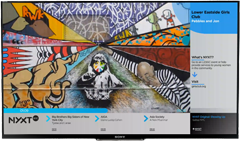In Press Play, we talk with leaders from educational and cultural organizations about their challenges, their experiences working with the community, and their goals. In this edition, we talked with Michael Rips, Executive Director at the Art Students League of New York, Jonathan Kuhn, Director for Art & Antiquities at the NYC Parks Department, and with the artists Gaia Grossi and Damon Hamm.
NYXT: What is Model to Monument?
Michael Rips: The M2M Program, which stands for Model to Monument, is perhaps the most important public project of The Art Students League. It is significant for the following reason: the Art Students League subsidizes monumental public sculptures for the parks of New York, specifically Riverside Park.
NYXT: How does the program work?
Michael Rips: Students from all over the country, and particularly in the League, put in an application with a proposal for a large public sculpture. The League then selects those four to eight sculptures whom the League considers to be the most promising in terms of their suggested projects.
We then have Greg Wyatt, who is an internationally known sculptor, head up the program and he mentors the finalists to the point where they have maquettes, which are small examples of their proposed sculptures, and then a selection is made and those selections are ultimately build either in our basement, in our sculpture studios, or at foundries outside the League, into monumental public sculpture.
NYXT: Do you collaborate with other organizations?
Michael Rips: We work very closely with Jonathan Kuhn and Jennifer Lantzas at Parks, who are brilliant curators of the sculpture and other art in the park, so it is a collaboration between the League and New York City to put these sculptures in the public parks of New York.
NYXT: How does the partnership with the New York City Department of Parks & Recreation work?
Jonathan Kuhn: This is a partnership with the Art Students League and the Parks Department that began about a decade ago. For seven years there was a program in the southern end of the park, known as Riverside South, not far from where the Art Students League is. This is the first installation that has been at this location. And it is a chance to give students an opportunity to take from a studio maquette to a large scale monumental art.
NYXT: How was the design process for your sculpture for M2M?
Damon Hamm: The sculpture where I am sitting on was conceived of by coming to this space and observing the people in the park, how the space was used, and trying to think about all the different ways you can enter the park, the kind of things that people might want in the park, and see what we can do with that.
NYXT: What did you envision for your sculpture at Riverside Park?
Gaia Grossi: I envisioned something very feminine, with a feminine energy, and intune with nature in the elements. So when I visited this particular side of the park, I saw all the little boulders in this field, and I thought it would be interesting to create a sort of mother figure to the boulders, a central figure that would unify the landscape in general. I also wanted the piece, being a public art piece, to be very welcoming and inclusive to the public, so, I envisioned an opening in it. And I wanted the opening to frame the view of the river in order to create a dialogue and a harmonious balance between the solidity of the stone and the fluidity of water.
NYXT: How was the construction process?
Gaia Grossi:I began working on small maquettes, mostly in clay and later on I developed mid-size maquettes. When I chose the right piece that I really wanted to make, I worked along with engineers, fabricators and designers to be able to actually give form to the monumental piece.
NYXT: How was the learning experience?
Damon Hamm: I was given the opportunity to really explore different things for a public space. A lot of the things that you may not think about become apparent, such as safety issues, logistics, and the longevity of materials put out in the open elements. Many things to consider when you are designing something that is for the public.
NYXT: What is the importance of public art?
Jonathan Kuhn: The public art program of the Parks Department began in 1967. And it is very important for a number of reasons: It gives opportunity to artists to create work in public settings and it gives the opportunity to the public to receive that art work, to just have it part of their daily lives. We don't charge admission, and we give the public a chance - a public by the way for which many people, especially children, never had the opportunity or rarely had the opportunity to go to a museum - to see works of art of all different sizes, materials, styles, subjects, and symbolism. We see it as a museum without walls, a gallery without walls, that satisfies a number of needs, both of creativity as well as public enjoyment and enhancement of our public parks.
Subscribe to the NYXT newsletter
Learn about upcoming events, volunteer opportunities, and new organizations looking for your help.


